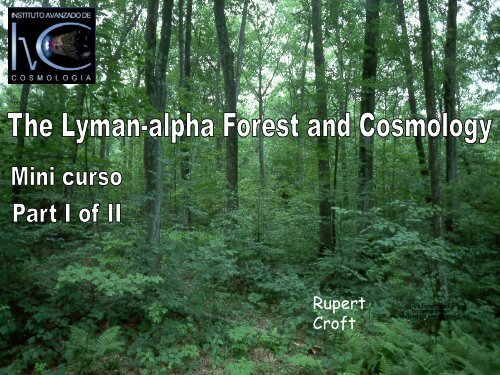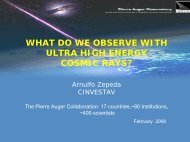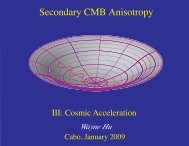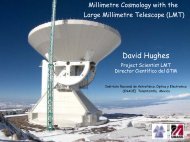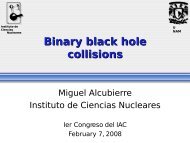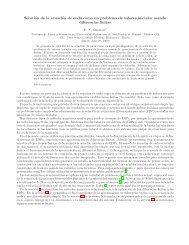Rupert Croft
Rupert Croft
Rupert Croft
- No tags were found...
Create successful ePaper yourself
Turn your PDF publications into a flip-book with our unique Google optimized e-Paper software.
<strong>Rupert</strong><br />
<strong>Croft</strong><br />
QuickTime and a<br />
decompressor<br />
are needed to see this picture.
Plan for lecture 1:<br />
• History : -the first quasar spectra<br />
-first theoretical models (all wrong)<br />
-CDM cosmology meets the Lya forest<br />
• The Lya forest in simulations<br />
• The Lya forest as cosmological tool:<br />
•Conclusions<br />
-the matter power spectrum<br />
-constraints on neutrino mass<br />
-baryon oscillations
Plan for lecture 2:<br />
• Recap : - The physics of the Lya forest<br />
• Searching for the ionized baryons: CMB-Lya cross<br />
correlations<br />
• The Lya forest and the cosmic radiation field<br />
• Searching the forest for light echoes from dead<br />
quasars<br />
• Measuring quasar and galaxy halo masses<br />
from the Lya forest around them.<br />
• The future of Lya forest studies
QuickTime and a<br />
decompressor<br />
are needed to see this picture.<br />
First optically<br />
identified<br />
quasar<br />
(Maarten<br />
Schmidt 1965)
Gunn and Peterson (1965)
Energy levels of a Hydrogen atom
We are<br />
interested in<br />
the transmitted flux, F:<br />
wavelength<br />
F=F observed<br />
F intrinsic quasar<br />
spectrum<br />
F=e -τ<br />
for H at mean density,<br />
of the Universe<br />
τ=10 6 !
Bahcall and Salpeter (1965)
First published high-z QSO spectrum:<br />
Lynds and Stockton (1966)
First published high-z QSO spectrum:<br />
Lynds and Stockton (1966)<br />
Lya<br />
forest
What is the mean<br />
density of baryons?<br />
It is less than<br />
4 particles per<br />
cubic meter.
ut from the absorption seen in spectra, the<br />
number density of neutral H atoms is 10 6 times<br />
less!<br />
Why? We think the Hydrogen is still there, but<br />
How do we detect these neutral atoms?
QuickTime and a<br />
decompressor<br />
are needed to see this picture.<br />
How do we detect these neutral atoms?
First published high-z QSO spectrum:<br />
Lynds and Stockton (1966)<br />
Lya<br />
forest
• If we take a spectrum of a quasar, we can see material<br />
in absorption:<br />
• Light travelling to us from the quasar gets<br />
redshifted by the expansion. When the<br />
wavelength of light gets to the Lyman-alpha<br />
wavelength, there is a probability that a<br />
photon will be absorbed by neutral hydrogen<br />
gas at that redshift.<br />
Ly-alpha<br />
emission line<br />
at quasar<br />
redshift
What is the physical interpretation of the<br />
absorption features we see?<br />
(1966-1994) The original picture:<br />
discrete small clouds + intercloud medium<br />
QuickTime and a<br />
decompressor<br />
are needed to see this picture.<br />
QuickTime and a<br />
decompressor<br />
are needed to see this picture.
The width of the clouds in this original model is set<br />
by thermal (Doppler) broadening and the intrinsic width<br />
(Lorentzian)because the clouds are physically very<br />
small in this model
Do these small clouds really exist?<br />
What are they physically?<br />
People tried to explain ….
Failed models<br />
QuickTime and a<br />
decompressor<br />
are needed to see this picture.<br />
Ejected from host QSOs<br />
QuickTime and a<br />
decompressor<br />
are needed to see this picture.<br />
QuickTime and a<br />
decompressor<br />
are needed to see this picture.<br />
Pressure confined clouds<br />
QuickTime and a<br />
decompressor<br />
are needed to see this picture.<br />
QuickTime and a<br />
decompressor<br />
are needed to see this picture.<br />
Dark matter confined clouds (minihalos)<br />
QuickTime and a<br />
decompressor<br />
are needed to see this picture.
The correct model:<br />
A fluctuating low density photoionized medium<br />
•absorption is caused by structures which have<br />
not yet undergone gravitational collapse<br />
•broadening is done by Hubble flow<br />
How did we find this out?<br />
First models by Bi (1991), Bi Ge & Fang (1992) using<br />
linear theory. But did not gain wide acceptance<br />
until advent of numerical simulations.<br />
e.g. Cen et al (1994), Hernquist et al (1996)
With the simulations we are effectively solving for<br />
dark<br />
matter<br />
dynamics<br />
Boltzmann<br />
eqn .<br />
Poisson<br />
equation.<br />
gas<br />
dynamics
The stars in a simulated universe
The baryons in a simulated universe
QuickTime and a<br />
decompressor<br />
are needed to see this picture.<br />
There is no intercloud medium<br />
-the clouds are the medium<br />
QuickTime and a<br />
decompressor<br />
are needed to see this picture.
absorption level in quasar spectra tells you how much<br />
neutral hydrogen there is along the line of sight
Simulated spectrum of background quasar.<br />
F=e -τ<br />
This Lyman-alpha “forest” can give us a 1D map of the density field.
Baryons trace dark matter well on scales above the<br />
pressure smoothing scale, ~100 kpc/h<br />
if we understand how the baryons are distributed,<br />
we can measure the clustering properties of the<br />
dark matter from the Lya forest.<br />
What is the physics involved?
Competition between<br />
photoionization<br />
heating<br />
adiabatic cooling from<br />
the expansion of the Universe<br />
drives gas elements<br />
onto a power-law<br />
temperature relation<br />
Hui & Gnedin (1997)<br />
α∼0.6
For the gas in photoionization equilibrium,<br />
photo<br />
ionization<br />
rate<br />
(The recombination rate for gas at these<br />
temperatures is proportional to T -0.7)<br />
We already know that so the neutral<br />
hydrogen density and hence optical depth τ:<br />
(known as the FGPA, Fluctuating Gunn-Peterson Approximation)
or more simply,<br />
Density of matter<br />
τ ∝<br />
[<br />
ρ<br />
( r)]<br />
J ( r)<br />
~<br />
1.6<br />
remember that<br />
F=e -τ<br />
(observable quantity)<br />
also<br />
Ionizing radiation intensity<br />
Analyses assume that J(r) is a constant (does not fluctuate<br />
spatially), so that measuring properties of F will give us<br />
properties of ρ (such as P(k))<br />
We assume this for now - we will drop this assumption tomorrow
Additional physics which could disrupt this simple picture:<br />
Star formation and supernova winds:
FGPA measured from simulation which includes<br />
additional physics (star formation, stellar winds etc)<br />
τ<br />
It works very well - we can use this knowledge to do cosmology
How do we quantify structure in the Universe?<br />
• One way to describe fluctuations<br />
statistically is to decompose them into<br />
Fourier modes (3 dimensional plane<br />
waves).<br />
• If we Fourier transform the Universe,<br />
we can get the density contrast at<br />
a point in space from a superposition<br />
of Fourier modes:<br />
Fourier amplitude<br />
for plane wave with 3d<br />
wavevector k<br />
(wavelength of mode<br />
is λ=2π/k)
• The variance of the mode amplitudes is known as the<br />
power spectrum:<br />
• P(k) tells you how large the fluctuations are for a<br />
given scale (for wavenumber k).
Here is the galaxy power spectrum, but what is the<br />
matter power spectrum?<br />
Surveys of different<br />
types of galaxies have<br />
different power spectra
People assume that on large scales,<br />
P galaxies (k) = b P matter (k)<br />
but what is b? Unknown “biasing”<br />
relation - cannot yet be predicted from<br />
first principles or using simulations.<br />
~<br />
However we know that for the lyman-alpha forest<br />
we can predict the “biasing relation”:<br />
observed<br />
quantity<br />
τ ∝<br />
[ ρ ( r)]<br />
J ( r)<br />
1.6<br />
matter density<br />
so we can use lyman alpha forest measurements<br />
to estimate P matter (k)
We measure clustering in 1 dimension, along a<br />
sightline. How is this related to 3D clustering?<br />
(Kaiser and<br />
Peacock 1991)<br />
3D<br />
power spectrum
First application, to a single quasar spectrum<br />
(RC et al, 1998)<br />
From the lyman alpha flux<br />
power spectrum<br />
to the matter power<br />
spectrum
SDSS<br />
quasar spectrum<br />
low quality spectra are still useful
Sloan Digital<br />
Sky Survey<br />
Data Release 1<br />
Bright quasars:<br />
= -27<br />
Mpc/h
flux power spectrum from<br />
3400 SDSS spectra<br />
McDonald et al (2006)
Why are measurements of matter clustering<br />
from the lya forest useful?<br />
Spergel<br />
et al (2003)<br />
The power spectrum of matter fluctuations constrains<br />
cosmology – but the WMAP and galaxy data can only probe large scales
From Max Tegmark’s webpage
Applications of Lyman alpha forest<br />
measurements.<br />
First - constraining the neutrino mass…
Massive neutrinos suppress the clustering of matter on small scales<br />
if they make up some fraction of the total matter density.<br />
Eisenstein<br />
and Hu (1998)<br />
This is because they are light enough that they were relativistic in the<br />
early Universe when they decoupled from the rest of matter.
The Lyman alpha forest works well<br />
to constrain the neutrino mass because it<br />
measures clustering on small scales:<br />
A simulation<br />
test<br />
which<br />
included<br />
massive<br />
neutrino<br />
particles<br />
(10 eV)<br />
(RC, Hu and Dave’ (1999))
Constraints on<br />
neutrino mass<br />
from combination<br />
of CMB and<br />
Lyman-alpha<br />
data<br />
These are<br />
from 1999<br />
current constraints<br />
are better<br />
~ 1 eV
Lya clustering can also<br />
constrain warm dark matter<br />
candidates, and rule<br />
out sterile neutrinos.
Even better<br />
limits from<br />
Viel et al (2007)
The Lya forest power spectrum can<br />
constrain inflationary parameters, like the<br />
scalar spectral index and the roll:<br />
From Seljak et al (2005)
The Lya forest will also be used in the<br />
future to constrain dark energy.<br />
QuickTime and a<br />
decompressor<br />
are needed to see this picture.
size of the<br />
sound horizon<br />
at matter-radiation<br />
equality<br />
WMAP<br />
Spergel et al<br />
QuickTime and a<br />
decompressor<br />
are needed to see this picture.<br />
Baryon acoustic oscillations make a<br />
standard ruler<br />
QuickTime and a<br />
decompressor<br />
are needed to see this picture.<br />
SDSS Galaxies z~0.3<br />
CMB z~1100<br />
Percival et al (2007)<br />
The Lyman alpha forest could do this at z~3
Need a survey<br />
with a huge volume<br />
and many spectra…
Predictions by McDonald and Eisenstein (2007)<br />
BOSS<br />
will measure<br />
acoustic scale<br />
to 1% at z=3<br />
(compare to<br />
~5% precision<br />
of present<br />
measurement at<br />
z~0.3)
Conclusions for part I<br />
• The lyman alpha forest arises in a<br />
fluctuating photoionized intergalactic medium,<br />
not from gravitationally collapsed objects.<br />
• Understanding this simple physics means<br />
that it provides one dimensional maps of the<br />
density field.<br />
• This can be used to do cosmology:<br />
-by measuring P(k) on smaller<br />
scales than is possible with<br />
the CMB and galaxy surveys<br />
• Upcoming surveys will enable us to<br />
move to even larger scales.


